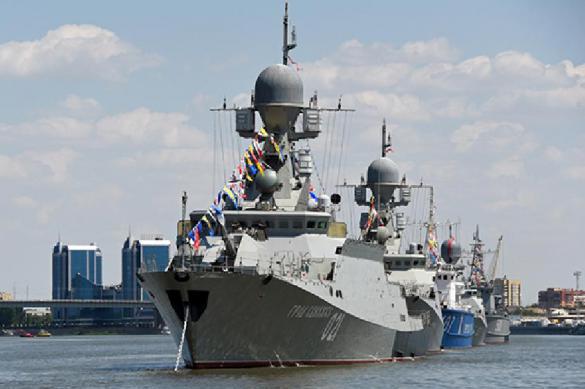
Russia’s Caspian Flotilla Gains an Air Arm
Publication: Eurasia Daily Monitor Volume: 16 Issue: 77
By:

Until the Russian Federation launched a barrage of cruise missiles against Syria from ships in the Caspian Sea in October 2015 (see EDM, October 26, 2015), few people in the West devoted much attention to Russia’s Caspian Flotilla, viewing it, if at all, as a purely coastal defense force (Riafan.ru, May 26, 2019). But in the three years since then, that unit of the Russian navy—the Military Maritime Fleet (Voyenno-Morskoy Flot—VMF)—has dramatically expanded its capabilities and role in Moscow’s thinking. And that trend is likely to only increase now that the new head of the VMF is Admiral Nikolay Yevmenov, a former commander of the Caspian Flotilla (Polit.ru, May 9). Indeed, the Flotilla’s current commander, Admiral Sergey Pinchuk, recently announced that, for the first time, his naval force will include amphibious military planes and helicopters (Regnum, May 22).
“We are forming an aviation squadron,” Admiral Pinchuk said. “It will be based in Kaspiysk and will consist of Be-200 planes and Mi-14PB helicopters,” giving the Caspian Flotilla an enhanced ability to conduct search-and-rescue operations and to provide medical care. Pinchuk’s statement is certainly true as far as it goes. But having this capability will also allow Russia’s local naval grouping to more effectively project power, especially now that this force is located not in Astrakhan, where it had resided since Soviet times, but in Dagestan, far down the sea’s western coast and closer to Azerbaijan, Iran and Turkmenistan. Indeed, a series of steps the Russian government has taken over the last year alone along with the prominence shown to the Caspian Flotilla over the last month during broader Russian military exercises strongly suggest that Moscow plans to use its new capability in exactly such a more offensively oriented manner.
In April 2018, Moscow shifted the home base of the Caspian Flotilla from the northern Caspian coastal city of Astrakhan to Kaspiysk (Dagestan), giving it greater freedom of maneuver and putting it closer to where its forces might be used (Pravda.ru, April 2, 2018; see EDM, June 4, 2018). The next month, Moscow showed that it viewed the Flotilla as something more than a launching pad for cruise missiles by deploying its ships to the Sea of Azov after passing them through the Don-Volga Canal (see EDM, May 31, 2018). Then, in June, Moscow added a marine unit to the Flotilla, giving it the ability to land forces anywhere along the Caspian coast and thus project Russian power there (see EDM, June 7, 2018). This rapid buildup in the Flotilla’s capacity sparked concerns among the other littoral states as well as nearby Ukraine (See EDM, November 27, 2018). And Kyiv has become even more apprehensive now that Moscow has again begun talking about expanding its internal canal system between the Caspian and the Sea of Azov, which would allow it to shift forces from one theater to the other even more rapidly (see EDM, March 26, 2019).
Recent weeks have produced more evidence that the Caspian Flotilla, long an afterthought for Moscow and others, is becoming far more important. Even Chinese naval analysts have recognized this fact, which should say a great deal, especially given that the Chinese reportedly were especially impressed by the Flotilla’s use of short-range rockets (Politros.com, May 9).
Among the most important developments this spring are the following: the Flotilla has now built new housing for its much larger naval and marine complement (Pravda.ru, April 2, 2018; Md-gazeta.ru, March 28, 2019). Its training and operations are being integrated not only with the Southern Military District, of which the Caspian is a part, but also with the Southern Federal District that oversees part of Russia adjoining the always restive North Caucasus (Redstar.ru, May 27). The Flotilla’s training and operations have been dramatically increased compared to a year ago, and these activities have been covered by Moscow television, something that also sends a message (Tvzvezda.ru, May 20). And finally—and perhaps most notably—the Caspian Flotilla, which in the past was often left out of all-Russian military games and Victory Day celebrations, this past month has been given a prominent role in both (Tvzvezda.ru, May 19).
It is always good practice to avoid inferring intentions from capabilities, but it is certainly the case that Russia’s Caspian Flotilla now has more firepower and sea-land capacities than do the navies of any of the other Caspian littoral countries. And at least some in Moscow increasingly view this Flotilla as a force capable of intimidating other regional actors and with the potential to project power more broadly in the Sea of Azov or via cruise missiles still more widely. It is not just a search-and-rescue or constabulary force that its commander wants people to believe it is; the Caspian Flotilla is increasingly a military force to be reckoned with, especially if the conflict in and around Ukraine continues or if the discord between Iran and the United States should shift from a war of words to something more.



